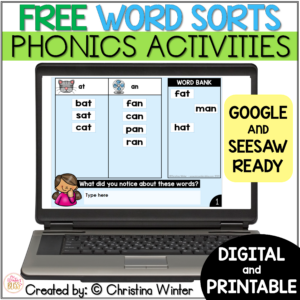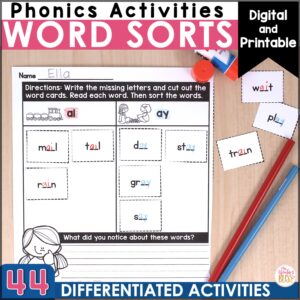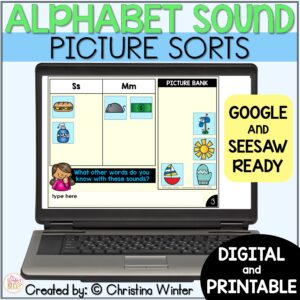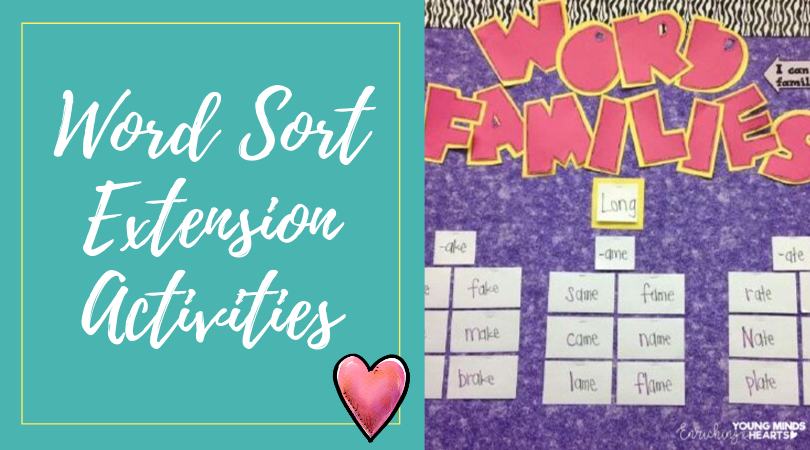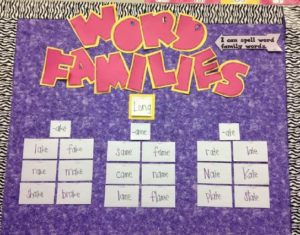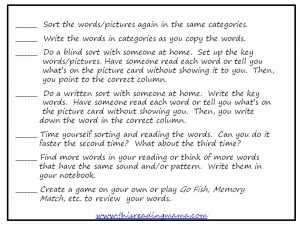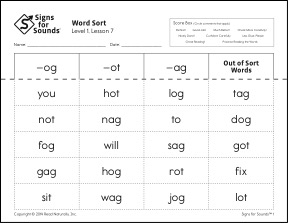Types of Sorts
One of my favorite ways to teach phonics skills is through word sorting activities. Today, I am sharing three different types of sorting activities and how they help our first graders increase their decoding skills. I’ll also share easy ways to incorporate these sorts into your instruction.
Picture Sorts
Students sort pictures into two or three categories in a picture sort. Place a header at the top of 2 or 3 columns and present students with various picture cards. Picture sorts focus on building phonemic awareness skills. So they are a great place to start!
Here are some examples:
- Beginning consonant sounds (great review at the start of the school year!)
- Comparing digraphs (sh vs. ch)
- Comparing short vowel sounds (i.e. short a vs. short o)
- Comparing long and short vowels (i.e. short i vs. long i)
- Where students hear a sound in a word (i.e. medial sound vs. final sound)
Word Sorts
A word sort is just like it sounds- students are sorting written words! Word sorts are a key activity to increase students’ word awareness. During a word sort students group words by common spelling patterns.
Here are some examples:
- Sort by word families
- Sort words by syllable patterns
- One example is sorting CVC vs. CVCe words.
- Comparing two to three sound/spelling patterns
- One example is sorting vowel team ai and ay words. After sorting, students can see when each type of spelling pattern is used; ai at the beginning or middle of a word, ay at the end of a word or syllable.
- Comparing the location of spelling patterns in words
- An example would be words that begin with sh and words that end with sh
Writing Sorts
Writing sorts are a dictation activity. Dictation is an excellent way for students to transfer decoding skills to their daily writing.
For this activity, students will need some type of writing materials. A worksheet with columns or a dry-erase board works great! Students will label the columns at the top and the teacher will orally dictate words for students to write in the correct columns. I also like to include a dictated sentence at the end that uses some of the sorted words.
You can grab a free writing sort by clicking the image below!
When and Why To Use Sorting Activities:
Picture Sorts: Picture sorts are essential in Kindergarten and the beginning of first grade. They help increase phonemic awareness skills.
Word Sorts: Use word sorts as soon as students begin reading cvc words. They help increase word awareness.
Writing Sorts: Can be used as soon as students are reading short vowel/cvc words. They help transfer word knowledge to daily writing.
Word sorting activities work great for whole class instruction, small groups, centers, and independent activities.
Planning for sorting activities:
You only need a few basic supplies for using sorts in your classroom! I love using a pocket chart for these activities. You need some header cards and some pictures. You can find great premade sets. Another option is to create your own header cards by writing the skill on index cards. You can also complete picture sorts on an interactive whiteboard, or students can complete their own sorts with a cut and glue worksheet.
Want some premade sorting activities? Check out these resources!
Word sorts are an engaging phonics activity for K-2 students who are learning how words work while developing word awareness skills. Make sure to download a FREE sample of these differentiated word sorts in this post.
When we first introduce a new phonics skill it is best to keep the instruction explicit, clear, and to the point. But as I discussed in my last blog post, in order for students to truly master the phonics skills we teach we must provide them with lots of opportunities for review and repetition!
Even when we know we need to provide this extra practice, it can be a real challenge to keep coming up with activities that are engaging and effective. In his book Phonics from A to Z, Wiley Blevins encourages us to have our students explore and play with letter sounds and suggests word sorts are a great way to do so!
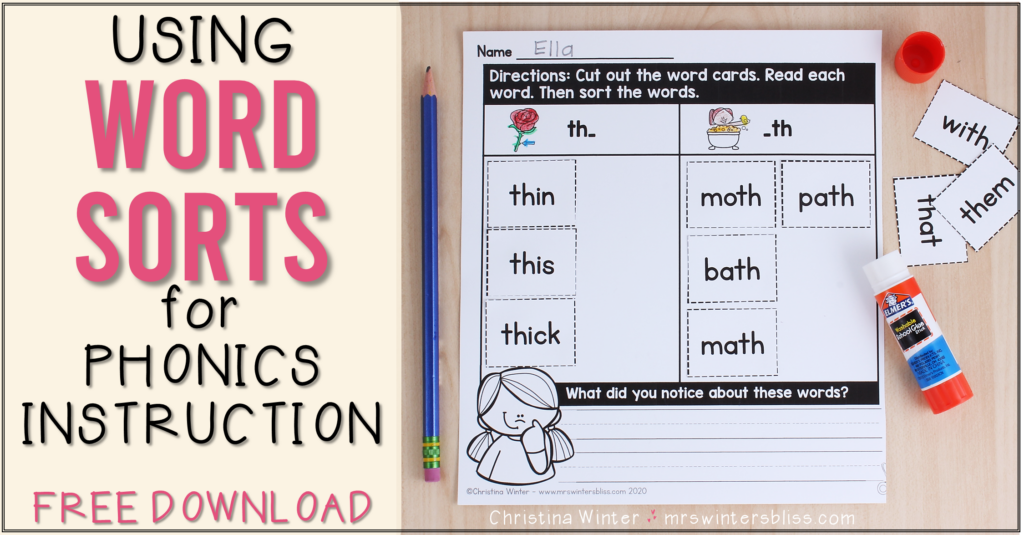
What are Word Sorts?
Word sorts require students to think about how words work by drawing their attention to common spelling patterns. Students are given a set of words that all have something in common and asked to sort them by the common feature.
There are many types of word sorts but the three most common are:
Open sorts: In an open sort, students are not told how to sort the words. They can sort them anyway they want. It is smart to start with an open sort because it gives you insight into students’ thinking and what they notice about words.
Closed sorts: In a closed sort, students are told how to sort words. Students visually scan the words for the pattern that you specified. The most valuable part of a closed sort is the conversation you have after the sort is complete. Blevins suggests questions like, What do you notice about these words? What do you notice about these spellings for long-o? Do you know other words with these spellings?
Timed sorts: In a timed sort, students are told how to sort a set of words but given a set amount of time to do so. A timed sort is a great thing to do with a set of words that students have been working with for a while. Students love the timed aspect which makes it feel like a game, but it also helps to train their eyes to quickly see larger word chunks which will help them when they encounter new and unfamiliar words.
Word Sort Routines
The routine for word sorts is simple! First, introduce the task by naming it and explaining the purpose.
Next, have students sort the words. If you’re doing a closed sort you’ll want to model one or two of the words. As students work, you can observe and ask students why they are putting specific words into each category.
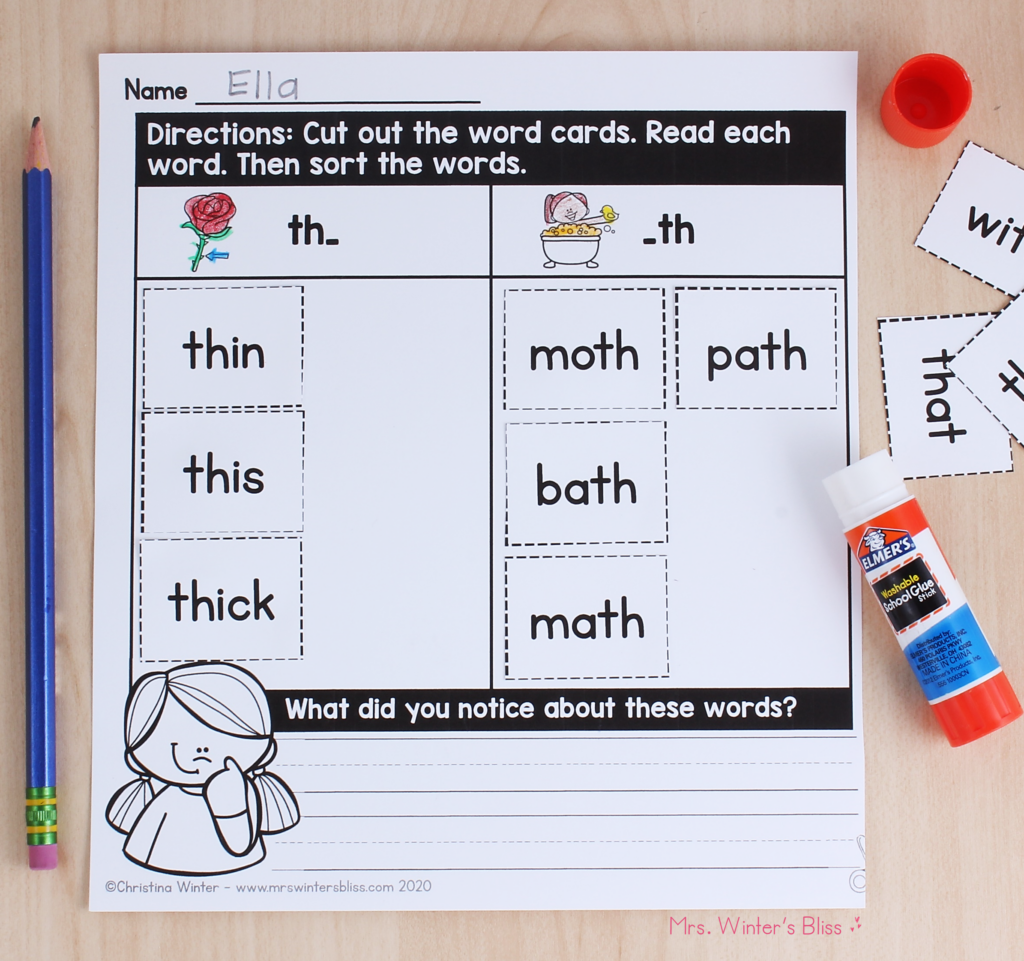
Finally, (and this is the most important one!) you’ll want to check and discuss the sort. Ask students what they learned about the words from doing the sort and guide them to the aspect that will help them in their future reading and writing!
Differentiated Word Sorts
Today I’m thrilled to share with you my very own Phonics Word Sort resource! These DIFFERENTIATED activities are both printable and digital so you can use them in the classroom or for distance learning with Google Classroom & Seesaw!

These word sorts are an engaging phonics activity to compliment your word study routines. There are two levels of word sorts: whole words and words with the missing target spelling pattern to assign to your students. Students will look for common spelling patterns, sort, then communicate what they notice and have learned about the words they’ve sorted.
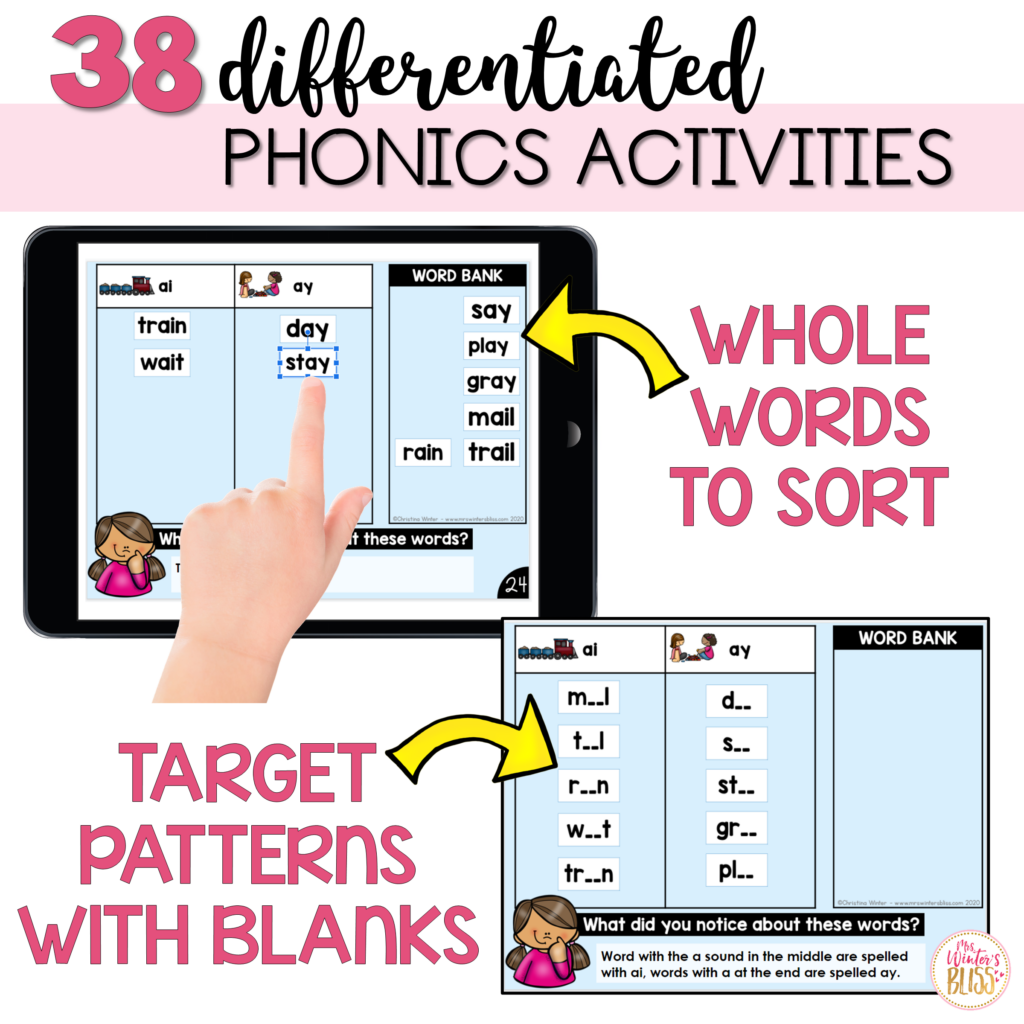
The resource includes the following Phonics Patterns:
- CVC Words
- Digraphs
- Blends
- Long Vowels
- Diphthongs
- R-Controlled Vowels
- Complex Vowels
All activities in the resource are all based on Wiley Blevins’ recommended scope and sequence for K-2 students. You can be confident that they are developmentally appropriate and provide the scaffolding students need for mastery.
Easy to Prep and Manage!
One of the major pitfalls with some word sorts is that they often require a lot of small pieces of paper, letter cuts, or word cards. They can take a long time to prep, distribute, and collect!
But NOT these activities! The printable pieces require very few cuts for students. There will be NO TIME wasted dealing with materials!
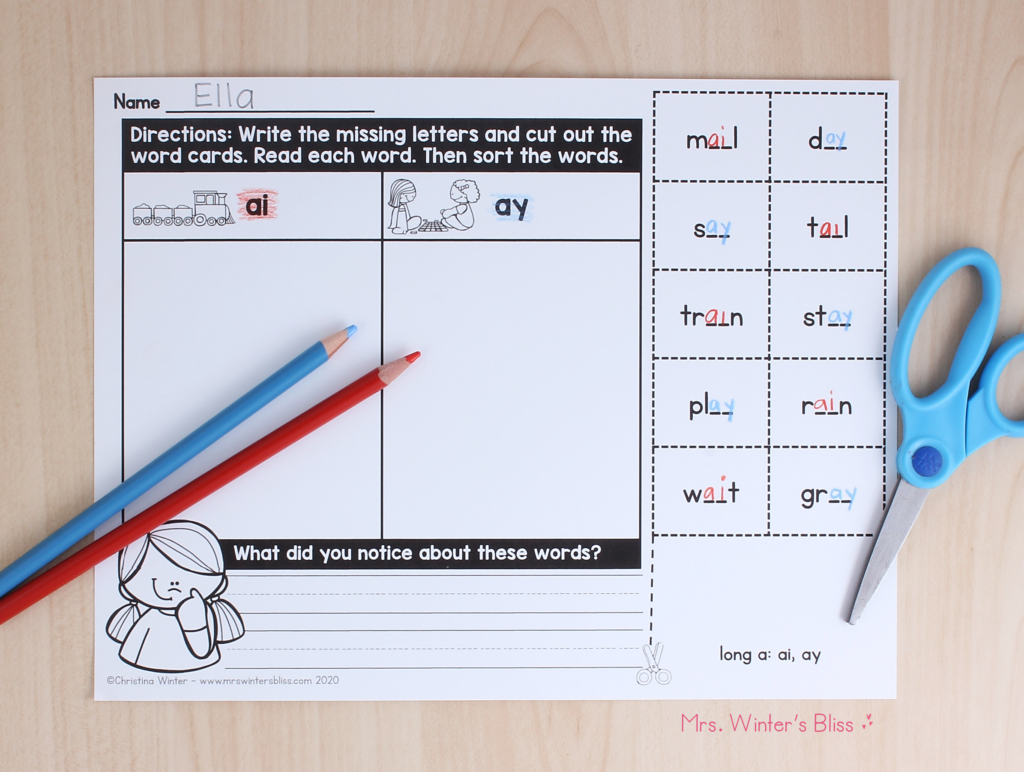
The digital version has been PRELOADED for you. With 1 click you add them to your Seesaw library or Google Drive and then you can assign them to your students for remote learning or individual centers!
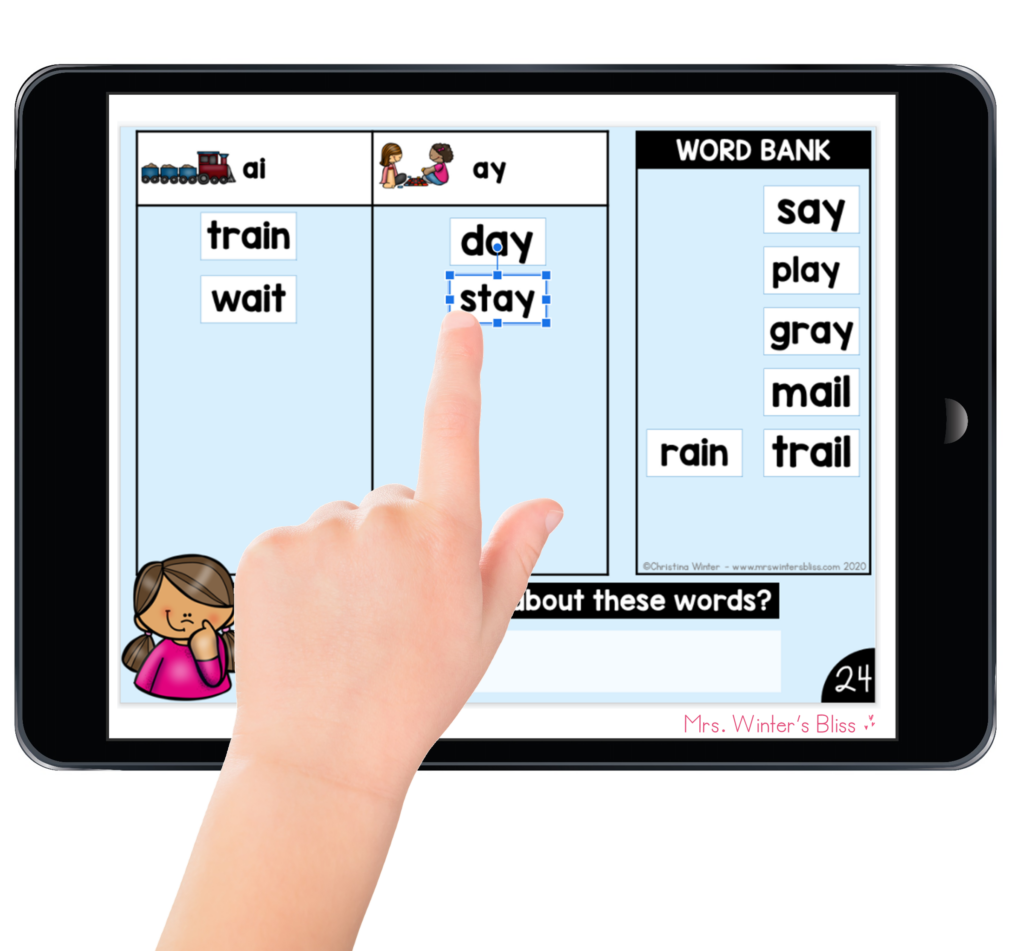
Another BONUS is that the structure of each word sort in the resource remains the same. This saves you from having to explain and model everytime you assign one! Once your students have successfully completed one sort, you can be sure they’ll be able to independently work through the rest at whatever pace you assign them! And with 38 different word sorts you’ll have enough to last you the ENTIRE YEAR!
Download FREE word sorts here:
-
FREE Phonics Word Sorts – DIFFERENTIATED – digital & printable
$0.00
Rated 4.86 out of 5 based on 7 customer ratings
-
Phonics Word Sorts – DIFFERENTIATED – digital & printable
$13.00
Rated 5.00 out of 5 based on 6 customer ratings
I hope the information and the word sorts I’ve shared today will make it easy for you to provide your students with meaningful practice that will allow them to develop their word awareness and master their phonics skills!
Be on the lookout for my next blog post where I’ll be sharing all about another great activity to help develop word awareness- Word Building Activities!
– SHOP THIS BLOG POST –
-
Phonics Word Sorts – DIFFERENTIATED – digital & printable
$13.00
Rated 5.00 out of 5 based on 6 customer ratings
-
Beginning Sounds Alphabet Sort – Google Slides, Seesaw, & worksheets
$8.00
–PIN for LATER–
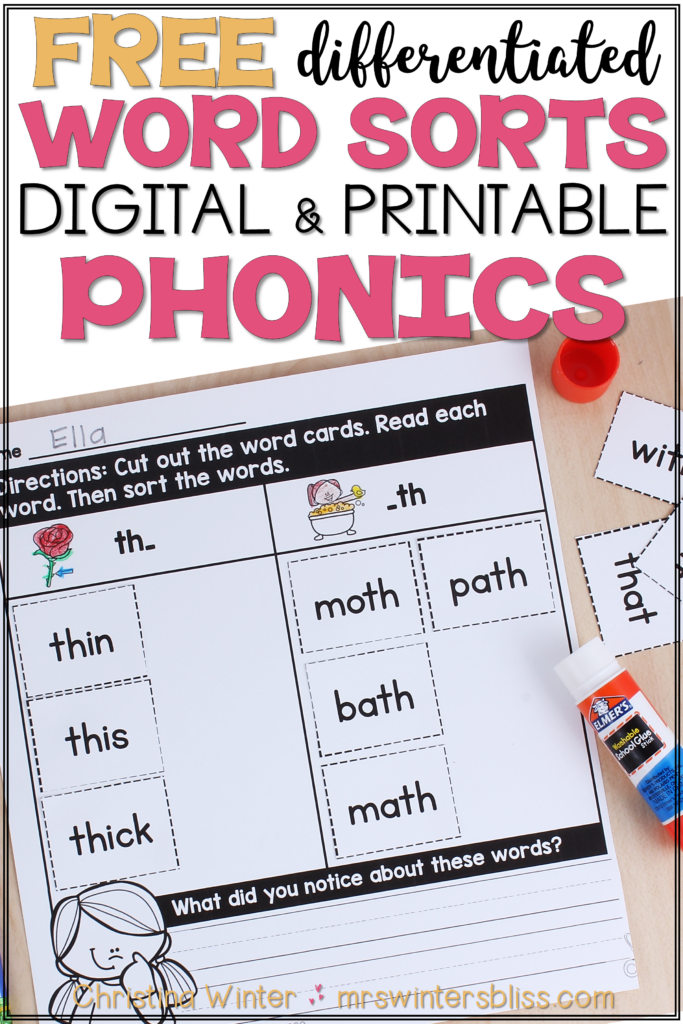
One of my favorite things about a word sort is that you can do SOOOOO many different things with them!! Let’s explore all of the cool things you can do with word sorts, to help students with reading fluency, comprehension, writing and more!
For Fluency
Fast “Pencil”
Once the sort is complete, use the utensil of your choice (pencil, pen, pointer, finger) to point to the words in the sort as quickly as your students can keep up. The goal of this activity is for students to get the ‘pencil’ to move as fast as they can. Make sure to mix up the order in case students have the order memorized. This is great for fluency as students are forced to move away from sound by sound decoding and toward reading the whole word in order for the pencil to move faster.
Words on a Ring

Word Sort Bulletin Board
As a culminating formative assessment, give your students one of the spelling patterns (og) and have them come up with as many words as they can that follow that pattern. Write those words on index cards and hang them up on a bulletin board for students to reference over time.
For Comprehension
Tell a Partner
Part of the structure of words is to understand what the words mean. Point to one of the words in the sort and have students tell a partner what that word means.
For Writing
Show What You Know
In order to incorporate the writing piece, give students a ‘pop quiz’ at the end of the sort. Flip all of the cards over and randomly give students one word at a time to write, to see if they wrote it correctly. This not only gives students the opportunity to write, but it also shows students the connection between speech and print.
Independent Practice
Interactive Notebooks
Provide individual copies of the word sort for your students. They can practice sorting and gluing the words into the correct place in their notebook. If they do this on Monday, they can use the notebook for other activities throughout the week. Click here (coming soon) for ideas on other things students can do in their word study notebook throughout the week.
Literacy Centers
Independent:
In my experience, students enjoy doing word sorts on their own, without the pressure of other students and/or an adult watching over them. Literacy centers are a great time for this. Make an extra laminated copy of your word sort, place it in a labeled baggie and have students practice the sort on their own. They can even do past sorts for practice and to keep up their fluency!
In a group:
Many younger students LOVE playing teacher. This would be a wonderful time for them to ‘facilitate’ a word sort with a group of their classmates. They can be the teacher and their peers the students. Even better if they rotate rolls and do the sort over and over. What great fluency practice!
Video Tutorial
Word Sorts?
Curious about word sorts or how to run them? Click here for more information!
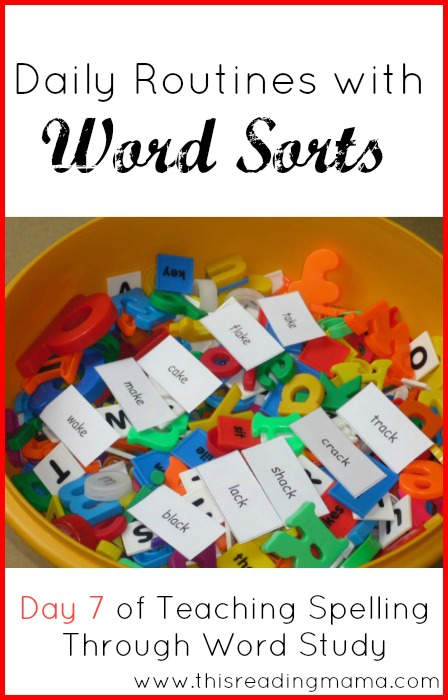
Welcome to This Reading Mama! I’m on my second week of Teaching Spelling Through Word Study, a 10-day series with the bloggers of iHomeschool Network. If you’ve missed any of the posts from this series, feel free to click HERE or on the image above to see all the topics covered thus far. Today, my goal is to post some of the routines that you can do each day with the words from your word sort of the week. The reason I like routine so much is that it helps to make the child work with more independence because he knows the “drill”.
These ideas are adapted from Words Their Way, but be sure to check out the link at the end to Spelling Mechanics Homeschool Word Study. In it, Ann gives more daily routine ideas!
1. Open Sort
Yesterday’s word sort introduction to a sort involved a closed sort. This means that the student knows from the beginning of the lesson what the categories are. When a child has word sorting down pat, sometimes it’s fun to introduce the words as an open sort. This means that all the words are placed in the space for the child to see, with the head patterns or words left out. The child looks at the words and tries to notice patterns within the words, creating her own sorting rule(s). Students may even think of a way to sort the words that wasn’t the intended pattern purpose for the sort and that works just fine.
2. Re-sort Words or Pictures
Simply resorting words again is an easy way to review the word sort. Ask the child to tell you the generalization from the sort.
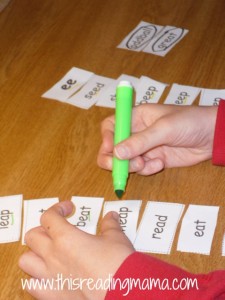
3. Timed Sort
The child can re-sort the words, but is timed as she does. Ask her to sort the words while you time her. Then she is asked to read the words. Time continues until all of the words are sorted AND read correctly. This can be repeated and the child can attempt to beat her own time. In a classroom setting, children can race against each other.
4. Blind Sort

5. Written Sort
This is played very much like the Blind Sorting Game (see #3), but instead of simply pointing to the correct category, the child writes it down under the correct category. To prep for this game, the head/key words are written across the top of a piece of paper. After the child spells the word that has been read aloud, the person reading the word places it under the correct column, and the speller checks his spelling. If it is incorrect, he erases and spells the word again under the correct column.
6. Word Hunts
I think out of all the routines, this one has got to be one of my favorites because it requires that students apply the pattern to reading and writing.
Before conducting a word hunt, students write the head patterns or words across the top of their piece of paper. So, if we use the AI and AY example from yesterday, the student would write an AI and an AY across the top of his paper. Using a text, the student searches for words that are “further examples of the sound, pattern, or meaning they are studying” (Words Their Way, 71). For example, if the child is studying the AY pattern, he may find words such as array or stray in his reading. These words would be written down in the AY column.

7. Word Study Notebook
As students word through their sorts for the week, they can keep a word study notebook of the word patterns they have learned. A spiral bound notebook works great as a word study notebook. As the child does various activities throughout the week with that sort (such as resorting/copying words, written sort, or word hunt), he or she uses the word study notebook to record them.
So far, ALuv and I have only used his word study notebook to get the sort down at the end of the week. He uses it as a make-shift word pattern dictionary for spelling and decoding. To give you an idea o the things we’ve done, here are a few examples from his notebook:
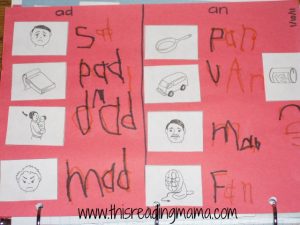
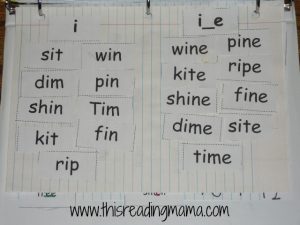
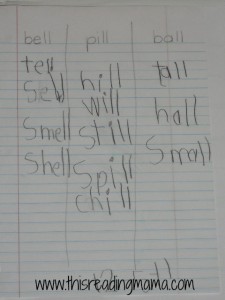
For more ideas on daily routines with word sorts, check out Spelling Mechanics! Ann has some FANTASTIC IDEAS HERE!
Keeping Track: One great way to keep track of the routines your child has used it to create some type of checklist, like the one you see below. (This is the one I used in tutoring, but the idea came from one of the co-authors of Words Their Way). Within the week, ask the child to complete 4 or 5 of the tasks and check them off.
More Resources with Word Sorts:
- 10 Days of Teaching Spelling Through Word Study {you’ve just read day 6 of this series}
- Word Study/Phonics Pinterest Board
A good educator finds strategies and programs that work and implements them in the classroom. A great educator begins with an effective strategy or program and then develops ways to extend the learning even further. Kristin McDaniel, a first-grade teacher in San Juan Capistrano, CA, is one of the great ones. Pleased with the results she was seeing from Read Naturally’s spelling program, Signs for Sounds, Kristin asked herself how she could capitalize on her students’ momentum. Was there a way to reinforce and solidify their understanding of the word patterns and high-frequency words featured in the program?
“I wanted my students to better understand the patterns the sound-out words share, and I wanted them to recognize the difference between these sound-out words and the spell-out (irregular high-frequency) words,” Kristin said.
So, Kristin took the words from each lesson in Signs for Sounds and created word sorts—activities that require students to group words by patterns. Students used “line-leader patterns” to create lists of words with shared patterns. “Students also separated the spell-out words and/or words that did not match one of the line leader patterns into their own column (Out-of-Sort Words), since there is no shared rule or pattern in these words,” Kristin explained.
Students did their word sort work independently after completing a Signs for Sounds lesson. With Kristin’s guidance, the Kindergarten, first-grade, and second-grade teams at her school now use Signs for Sounds along with the word sorts. “All three teams report improvements in word recognition and decoding in guided reading and improvements in spelling while writing,” Kristin said.
Inspired by Kristin’s story, we wanted to make printable word sorts easily available to all of our customers who are using Signs for Sounds 1. The Signs for Sounds Level 1 Word Sorts and the Signs for Sounds Level 2 Word Sorts are available as free downloads on the Read Naturally website.
Students can work on the word sorts as independent work after completing lessons, as Kristin’s class does, or the teacher can direct the word sort activity during small group instruction. Teachers can consider several options when assigning the word sorts:
1) After the student cuts the words apart and sorts the words below the line-leader patterns in the header, the teacher (or another adult) can check the student’s work. Then the words can be gathered into a plastic zip bag or envelope and used again to sort and review the words the next day.
2) The student can be directed to cut the words apart, sort the words, and then glue the header and each word in the correct column on a second piece of paper. This allows the teacher to check the student’s work at a later time.
3) When checking a student’s work, the teacher can extend this independent work a step further. By directing a student to read the words down each column and across each row, the teacher can confirm that the student is able to read each word within the pattern (reading down), mix the patterns (reading across), and read the “Out-of-Sort Words.”
Here is an example of a Word Sort. Students cut along the dotted lines and then sort the words into their correct column based on the pattern in the header.
Example of a Reproducible Word Sort from Signs for Sounds Level 1 (Lesson 7)
We love when educators like Kristin extend their students’ learning using Read Naturally materials. Thank you, Kristin, for sharing your story and making your word sorts for Signs for Sounds available for other teachers!



